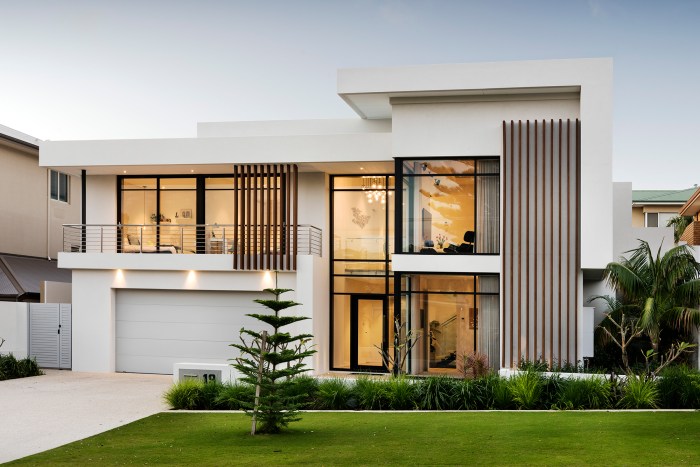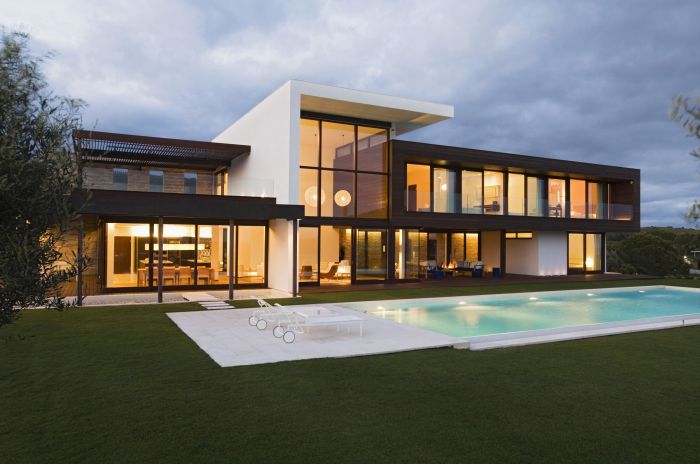Crafting a Modern Haven: Exploring Contemporary House Design
Step into the world of contemporary houses where sleek lines, innovative design, and sustainable practices converge to create stunning living spaces. From the use of eco-friendly materials to the seamless integration of indoor and outdoor areas, contemporary house design offers a glimpse into the future of architecture.
Join us on a journey through the key characteristics, interior design elements, sustainable practices, and outdoor spaces of contemporary houses.
Characteristics of a Contemporary House

Contemporary houses are known for their sleek and modern design, often incorporating open floor plans and large windows to maximize natural light. These homes focus on clean lines, minimalistic aesthetics, and the use of cutting-edge materials.
Key Features of Contemporary Houses
- Open floor plans that create a sense of spaciousness and flow throughout the home.
- Large windows and glass walls to blur the boundaries between indoor and outdoor spaces.
- Flat or low-pitched roofs with clean lines and geometric shapes.
- Use of industrial materials like steel, glass, and concrete for a minimalist and modern look.
How Contemporary Architecture Differs from Traditional Styles
- Contemporary architecture focuses on innovative design concepts and experimentation with materials, while traditional styles often emphasize historical elements and ornamentation.
- Contemporary houses prioritize function over form, with an emphasis on simplicity and efficiency.
- Traditional styles are characterized by intricate detailing, symmetry, and a more ornate appearance compared to the clean lines and minimalism of contemporary architecture.
Use of Materials in Contemporary House Design
- Glass: Used extensively to bring in natural light and create a seamless connection between indoor and outdoor spaces.
- Steel: Often used for structural elements and to add a modern industrial touch to the design.
- Concrete: Utilized for its durability and versatility, often seen in flooring, countertops, and accent walls.
Innovative Design Elements in Contemporary Houses
- Green roofs and living walls to incorporate nature into the design and promote sustainability.
- Smart home technology for increased energy efficiency and convenience.
- Flexible living spaces that can be easily adapted to different needs and preferences.
Interior Design in Contemporary Houses
Contemporary house interiors are known for their sleek and modern design elements that create a sense of openness and sophistication. The interior design of contemporary houses often focuses on creating a harmonious flow between spaces, utilizing natural light, minimalist furniture, and a careful selection of colors and textures.
Open Floor Plan Concept
The open floor plan concept is a hallmark of contemporary house interiors, where walls are minimized or eliminated to create a seamless transition between living spaces. This design approach allows for better flow of natural light, enhances the sense of spaciousness, and promotes a more social and interactive environment within the home.
Role of Natural Light
Natural light plays a crucial role in contemporary house design, as it not only illuminates the space but also creates a connection to the outdoors. Large windows, skylights, and glass doors are often used to maximize the entry of natural light, creating a bright and airy atmosphere that contributes to the overall aesthetic of the interior.
Minimalist Furniture and Decor
Contemporary interiors often feature minimalist furniture and decor, characterized by clean lines, simple forms, and a focus on functionality. This design approach eliminates clutter and unnecessary ornamentation, creating a sense of calm and order in the space. Neutral colors, such as white, gray, and beige, are commonly used to complement the minimalist aesthetic.
Colors and Textures
Colors and textures are carefully selected and utilized in contemporary house design to create visual interest and depth. Neutral color palettes are often paired with bold accents to add pops of color and create a focal point in the space.
Textures such as wood, metal, glass, and stone are integrated to add tactile appeal and contrast, enhancing the overall design of the interior.
Sustainable Practices in Contemporary House Design

Incorporating sustainable practices in contemporary house design is crucial for reducing the environmental impact of buildings and promoting a healthier living environment. This includes using eco-friendly materials, implementing energy-efficient features, and integrating green technologies.
Incorporation of Eco-Friendly Materials
- Bamboo: A sustainable alternative to traditional hardwood flooring, bamboo is fast-growing and renewable.
- Recycled materials: Utilizing materials like reclaimed wood, recycled glass, and repurposed metal reduces waste and conserves resources.
- Low-VOC paints and finishes: Volatile organic compounds (VOCs) in paint can be harmful to health and the environment, so using low-VOC options is essential.
Energy-Efficient Features
- Solar panels: Generating electricity from sunlight, solar panels help reduce reliance on non-renewable energy sources.
- High-efficiency HVAC systems: Heating, ventilation, and air conditioning systems designed for optimal energy performance contribute to lower utility bills.
- Energy-efficient windows and insulation: Properly insulated homes with energy-efficient windows help maintain indoor temperatures, reducing the need for heating and cooling.
Importance of Sustainable Architecture
Sustainable architecture in contemporary housing plays a crucial role in mitigating climate change, conserving natural resources, and creating healthier indoor environments. By reducing energy consumption, water usage, and waste generation, sustainable practices contribute to a more sustainable future.
Integration of Green Technologies
- Smart home systems: Automation technology allows homeowners to monitor and control energy usage, lighting, and appliances for optimized efficiency.
- Green roofs: Plant-covered roofs provide insulation, reduce stormwater runoff, and improve air quality.
- Greywater recycling systems: Reusing water from sinks, showers, and laundry for irrigation or flushing toilets reduces water waste and promotes water conservation.
Outdoor Spaces and Landscaping in Contemporary Houses
Contemporary house design places a strong emphasis on outdoor living spaces, recognizing the importance of connecting the interior of the home with the surrounding environment. Outdoor areas are seen as extensions of the indoor living spaces, creating a seamless flow between the two areas.
Emphasis on Outdoor Living Spaces
In contemporary house design, outdoor living spaces are carefully planned and integrated into the overall layout of the home. This includes features such as patios, decks, and outdoor kitchens that are designed to enhance the homeowner's lifestyle and encourage outdoor activities.
- Outdoor seating areas are often strategically placed to take advantage of natural light and views, creating inviting spaces for relaxation and entertainment.
- Landscaping elements such as native plants, trees, and shrubs are used to soften the transition between indoor and outdoor spaces, creating a harmonious connection with nature.
- Water features like fountains or pools are incorporated to add a sense of tranquility and luxury to outdoor areas.
Landscaping to Complement Contemporary House Architecture
Landscaping plays a crucial role in complementing the architectural style of contemporary homes. The goal is to create a cohesive and visually appealing design that enhances the overall look of the property.
- Modern landscaping techniques such as xeriscaping, which focuses on using drought-resistant plants and efficient irrigation systems, are often employed to create sustainable and low-maintenance outdoor spaces.
- Clean lines, minimalistic plantings, and geometric shapes are commonly used in landscaping to complement the sleek and streamlined architecture of contemporary houses.
- Outdoor lighting is strategically placed to highlight key landscaping features and create a welcoming ambiance during the evening hours.
Blending Indoor and Outdoor Areas
One of the key trends in contemporary house design is the seamless integration of indoor and outdoor areas, blurring the lines between the two spaces. This design approach enhances the sense of openness and connection with nature.
- Sliding glass doors, retractable walls, and large windows are commonly used to create a fluid transition between indoor and outdoor spaces, allowing for easy access and maximizing natural light and ventilation.
- Outdoor rooms such as covered patios or sunken gardens are designed to function as extensions of the interior living spaces, providing additional areas for relaxation, dining, or entertaining.
- Rooftop gardens and green roofs are innovative features that bring nature closer to home, providing a private outdoor retreat and promoting environmental sustainability.
Innovative Outdoor Features in Contemporary House Designs
Contemporary house designs often incorporate innovative outdoor features that enhance the overall aesthetic and functionality of the property. These features are designed to elevate the outdoor living experience and create unique focal points in the landscape.
- Outdoor fire pits or fireplaces are popular additions that provide warmth and ambiance for outdoor gatherings, extending the usability of outdoor spaces into the cooler months.
- Vertical gardens or living walls are creative landscaping solutions that add a touch of greenery to outdoor areas while maximizing limited space, making them ideal for urban settings.
- Sustainable design elements such as rain gardens, permeable paving, and green infrastructure are integrated into the landscaping to manage stormwater runoff, improve water quality, and promote environmental sustainability.
Last Word
As we conclude our exploration of contemporary house design, it becomes evident that these architectural marvels not only embody style and sophistication but also prioritize functionality and environmental consciousness. The blending of form and function, coupled with a focus on sustainability, sets contemporary houses apart as beacons of modern living.
Whether it's the seamless flow of indoor and outdoor spaces or the use of cutting-edge materials, contemporary house design continues to push boundaries and inspire awe.
FAQs
What sets contemporary houses apart from traditional styles?
Contemporary houses focus on clean lines, minimalism, and innovative use of materials like glass and steel, contrasting with the more ornate and traditional features of other architectural styles.
How important is natural light in contemporary house design?
Natural light is a crucial element in contemporary house design as it not only enhances the overall aesthetic but also contributes to energy efficiency by reducing the need for artificial lighting during daylight hours.
What are some common sustainable features found in contemporary houses?
Eco-friendly materials, energy-efficient systems, and green technologies such as solar panels and rainwater harvesting are commonly incorporated into contemporary house designs to promote sustainability.
How do contemporary houses blend indoor and outdoor living spaces?
Contemporary houses often blur the lines between indoor and outdoor areas through the use of features like sliding glass doors, outdoor kitchens, and seamless transitions from interior spaces to outdoor patios or gardens.




